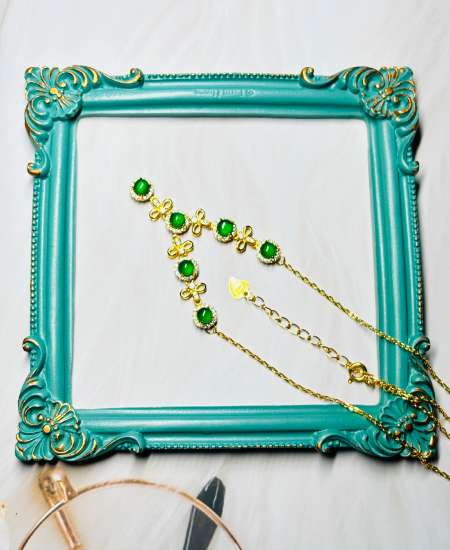1. How to choose and Evaluate Jadeite
1.1. How to choose Jadeite
- Color of Jadeite
In nature, jadeite comes in various colors such as red, yellow, brown, green, lavender, and white. However, the most popular and sought-after color is Imperial Green, an emerald green shade.
The value of jadeite increases with the intensity of its green color. Besides vibrant green and transparency, the color must be uniform to be considered top quality. Additionally, jadeite with a bluish-purple hue and translucent white is also highly valued.
In reality, the color of jadeite can change over time due to geological and climatic influences. Nevertheless, regardless of conditions, its inherent beauty and true value remain intact.
- Transparency
The value of jadeite, like other gemstones, heavily depends on its transparency. Not only with jadeite, but other types of gemstones are also often assessed based on this criterion.
- Surface quality of Jadeite
The surface of jadeite should be smooth, with a solid texture, bright, and free of rough crystals, cracks, or specks. Any impurities affect the quality of jadeite.
When considering both transparency and surface quality, jadeite can achieve superior standards.
Natural jadeite products can be valued at thousands, or even millions, of USD. This value diminishes if the surface quality is not outstanding.
- Shape
The majority of jadeite rings are egg-shaped, and this shape significantly affects the value of the gemstone.
Additionally, the value of jadeite also depends on its size and thickness. When the quality of the jadeite is comparable, larger sizes and greater thickness are important factors in determining price. Furthermore, the intricacy of the jewelry carving and its symbolic meaning also have a significant impact on the value of the jadeite.
1.2. How to identify authentic and Genuine Jadeite
Jadeite is valuable, and natural jadeite is not easy to come by, leading many to counterfeit it for profit. Therefore, when purchasing jadeite rings or jewelry, you should test the jadeite using the following methods:
- Using the naked eye
You can use the naked eye to distinguish jadeite based on its structure and luster. Check the surface: genuine jadeite should feel cool to the touch, have high transparency, and feel heavy.
Type A Jadeite: Under natural light or a lamp, Type A jadeite should appear glossy and smooth like glass.
Type B Jadeite: The luster of Type B jadeite resembles that of candle wax. If it has been bleached, it may have a yellowish tint and a slightly dull texture. Type B jadeite is usually lighter, with less distinct color and difficulty in seeing the original hue, whereas Type A jadeite displays clear and harmonious colors and patterns.
Additionally, merchants may tap the surface of the jadeite to hear a clear, resonant sound without impurities. If the sound is melodious and responds well, it indicates genuine jadeite. This action helps verify that the jadeite has a tight structure and good quality without cracks.
- Using fire
Apply a small flame for about 2 minutes. Genuine jadeite is almost unaffected by the flame.
Real jadeite will not change color, while fake jadeite may show soot or bubbles.
- Using a flashlight
Shine a flashlight through the jadeite to check for natural cracks. If you see slight cracks, it is genuine jadeite. If there are air bubbles, it indicates fake or treated jadeite.
If the jadeite has impurities, there will be air bubbles inside. Treated jadeite may have round patterns and lack natural brilliance.


2. Phân loại Ngọc Phỉ Thúy
Ngọc Phỉ Thúy có nhiều chủng loại với tên gọi và độ quý hiếm khác nhau xếp theo cấp bậc. Dưới đây là một số loại phổ biến nhất hiện nay:
- Ngọc Phỉ Thúy Băng Chủng
- Ngọc Phỉ Thúy Lão Khanh Chủng
- Ngọc Phỉ Thúy Thủy Chủng
- Ngọc Phỉ Thúy Tử La Lan
- Ngọc Phỉ Thúy Bạch Để Thanh
- Ngọc Phỉ Thúy Hoa Thanh
- Ngọc Phỉ Thúy Hồng Phỉ
- Ngọc Phỉ Thúy Du Thanh
- Ngọc Phỉ Thúy Ba Sơn…
Trong đó loại Thủy Tinh Chủng được coi là thượng phẩm, có hàm lượng nước đặc biệt cao, được gọi là Băng Chủng, có thể coi là đỉnh cao trong các loại Thủy Tinh Chủng.
Phân loại ngọc Phỉ Thúy theo giá trị:
- Loại 1: Đặc biệt
Ngọc bích (Jadeite) hay cẩm thạch hoàng đế hay còn được gọi là ngọc Phỉ Thúy hạng A. Nó được coi là ngọc của các vị vua chúa hoặc những người thuộc dòng dõi hoàng tộc từ xa xưa mới có thể sở hữu. - Loại 2: Thương mại cấp
Thương mại cấp hay còn gọi là Jadeit thương mại – ngọc Phỉ Thúy, cẩm thạch thiên nhiên loại B hay loại - Loại 3: Cấp bình thường
Cấp bình thường, hay còn gọi là loại thông thường, là loại phổ biến của cẩm thạch thiên nhiên từ các bìa ngọc hoặc ngọc Phỉ Thúy non được xem là loại 3 khá phổ biến.







